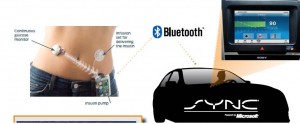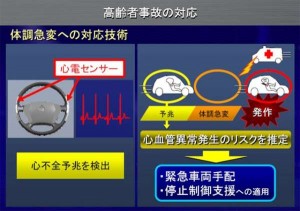Pathologists take note! In-car health management services are intended to further patient-centered healthcare
If a smartphone can be configured to perform a medical laboratory test, then why can’t some clinical lab tests be performed by an automobile? Believe it or not, several car companies are preparing to introduce these types of features into their automobiles in coming years!
First out of the box with the concept of “lab testing in an automobile” are carmakers Ford Motor Company (NYSE: F) and Toyota Motor Corporation (NSYE: TM). Each company has teamed up with healthcare device companies to develop in-car connectivity solutions. The goal is to provide in-vehicle medical testing capabilities that empower consumers with chronic illnesses or medical disorders to manage their condition while on the road.
It was last year when Ford Motor Company and Medtronic, Inc. (NYSE: MDT), announced a research partnership. They want to link glucose monitoring devices manufactured by Medtronic with the auto manufacturer’s in-car infotainment system.
According to K. Venkatesh Prasad, Group and Technical Leader, Infotronics Research & Innovation Team at Ford, the platform will probably flash alerts in either the audio display or the center stack display should someone in the car becomes hypoglycemic.
Helping the huge and still-increasing numbers of people with chronic diseases is one major factor that motivate corporate decision makers to invest in medical technology, a story in Modern Healthcare stated. Companies from various industries are investing in or partnering with traditional pharmaceutical and device manufacturers on medical products.
“We’re going to have a patient-centered healthcare system in the future,” observed Gerry McDougall, Head of Personalized Medicine and Health Sciences Practices at PricewaterhouseCoopers (PwC). McDougall pointed to policy and regulatory healthcare reform as possible accelerators of that trend. “We’re seeing very large companies move into that space in aggressive fashion,” he noted.

Here is how Ford Motor Company is collaborating with Medtronic to achieve glucose monitoring inside a Ford automobile. When the driver is wearing the Medtronic continuous glucose monitoring device, the prototype system allows Ford’s sync system to connect via Bluetooth. In real time, the audio display or the center stack display in the vehicle will show glucose levels and trends. If glucose levels fall to low levels, the system can provide alerts, including a through audio and a center stack display and provide secondary alerts if levels are too low, including verbal warnings that play over the automobile’s sound system. (image by Ford Motor Company.)
Also last year, Ford announced a partnership with WellDoc aimed at integrating WellDoc’s software-based diabetes and asthma management services into Ford vehicles. The project will make it possible for adults with type 2 diabetes to manage their disease.
The plan is to use WellDoc’s® DiabetesManager® System delivered through Ford’s SYNC voice-activated in-car connectivity system. The FDA-cleared DiabetesManager is a mobile phone-based system that provides automated, real-time clinical and behavioral coaching based on patient data. These developments were reported in a press release issue by Ford Motor Company.
“People with diabetes must adhere to a strict regimen to manage their disease,” said Anand K. Iyer , Ph.D., MBA, President and COO of WellDoc. “[These innovations will help] those with diabetes to be continuously connected to the tools that help them maintain their daily routines without interruption.”
Yet a third Ford partnership, this time with SDI Health, seeks to integrate SDI’s mobile allergy alert application through Ford’s Sync system.
Real-time In-car Services Have Continuous Connectivity for Patients and Providers
“Many people spend hours behind the wheel, making cars a convenient and private environment for delivery of health and wellness coaching,” stated Gary Strumolo, Manager of Infotainment, Interiors, Health and Wellness in the Ford Research and Innovation division. “It’s the only logical place for people to manage their health while on the go.”
Strumolo made the comments at the 2012 International Consumer Electronics Show (CES) in Las Vegas held in January, where Ford dubbed its new in-vehicle health monitoring initiative “the car that cares.” WellDoc’s Information Week Healthcare reported this story.
“Our goal is to further innovate the automotive space by incorporating health and wellness services into the car,” added K. Venkatesh Prasad, Group and Technical Leader, Infotronics Research & Innovation Team, Ford Motor Company. “Delivering real-time in-vehicle health management services is a revolutionary concept.”
In his remarks at CES, Strumolo made clear, however, that Ford would not allow Sync to diagnose medical conditions because that might require U.S. Food and Drug Administration (FDA) approval. “There is a line we will never cross,” Strumolo said. “It has never been our intention to turn your car into a medical device or a diagnostic system.”
Next Up, In-car Electrocardiogram Sensors
Both Ford and Japanese auto manufacturer Toyota are in “very early stage” development of in-car electrocardiogram (ECG) sensor products.
Toyota is working on a direct-contact electrocardiogram (ECG) sensor built into the steering wheel, reported MedGadet.com. The device works through an optical sensor mounted in the steering wheel that picks up a single-lead ECG signal. The system then uses the display to alert the driver to any abnormalities that need attention.

For its in-car electro-cardiogram (ECG) sensing system, Toyota Motor Corporation is using contact sensors in the steering wheel that pick up a single-lead EGG signal. By contrast, Ford is using contactless sensors in the driver’s seat for its ECG sensing system. Toyota’s system then uses the display in the vehicle to alert the driver about any abnormalities that need attention. Toyota showed a demonstration of this system in a Prius. In that demonstration, the chart of the driver’s heartbeat and electrocardiogram was displayed on the in-car navigation system. Beyond the value of alerting the driver to any serious conditions, Toyota stated that its system would also have value because it would function as a daily health check. (Image by Toyota Motor Corporation.)
Last year, Ford unveiled its version of electrocardiogram sensing in the form of a driver’s seat that contained a built-in, contactless ECG sensor. The seat has six built-in sensors that collectively produce a signal very similar to a single lead ECG. The sensors were developed by Aachen University in Germany. According to Ford, the seat produces accurate readings during 98% of driving time for 95% of drivers.
Dark Daily has long-predicted that new technologies will make it possible to move many medical laboratory tests outside of the traditional high-volume central medical laboratory facility. However, few clinical laboratory and pathologists would have predicted that major automobile manufacturers such as Ford and Toyota would want to incorporate diagnostic sensing capabilities in their car—let alone have these features installed and ready for new car buyers in just a few years!
—Pamela Scherer McLeod
Related Information:
Ford In-Car Health and Wellness Solutions: Medical Device Connectivity via Bluetooth
Ford Prepares SYNC to Protect Its Drivers’ Health
Toyota to Integrate ECG Sensors Into Steering Wheels
InformationWeek Healthcare: Ford Shows ‘Car That Cares’ At CES




Thanks for your comments, Teresa. You show keen wit. Given your perceptions about the consequences of multi-tasking in the driver’s seat of an automobile, it is with some trepidation that I raise the point that more than one Japanese company has a toilet that performs medical tests!
“Toto, one of the global toilet market’s most innovative brands, is giving us “The Intelligent Toilet,” a commode that uses your bodily waste to measure your blood pressure, urine sugar levels, temperature, and other things that we Westerners thought only leeches could do.”
Enough has been said, at this point. Your comments were certainly enjoyed at this office.
Should be an excellent cost savings feature. From all the deaths from accidents caused from drivers looking at their medical results, we will have fewer patients in the system! Hopefully, we really won’t just injure folks terribly which might “drive” up the costs.
I had suggested we install microwaves and fridges near the driver so they can make meals while driving. The fridge could double duty to store specimens and samples if we also build into the medical devices, while we are at it, the ability to provide blood and urine samples. That urine sample idea triggers other ideas…. But you get my “drift”. NO!!! Don’t drift! Drive.
Did I miss something?